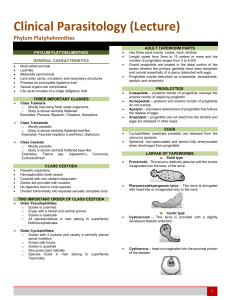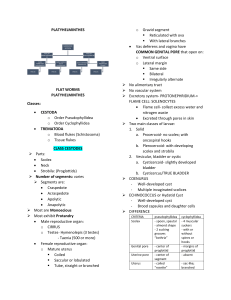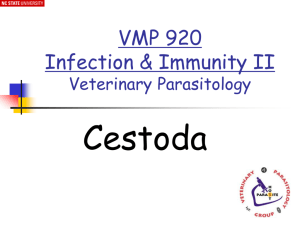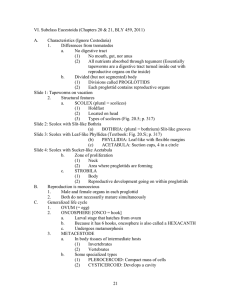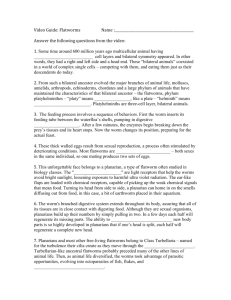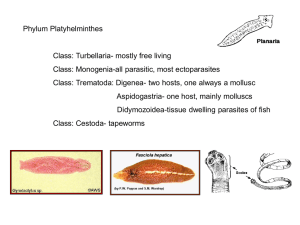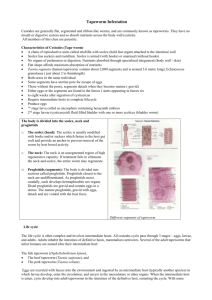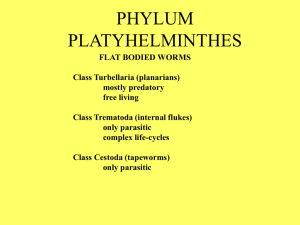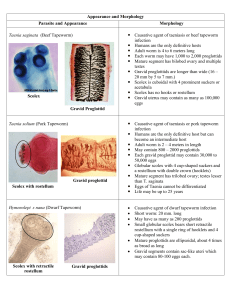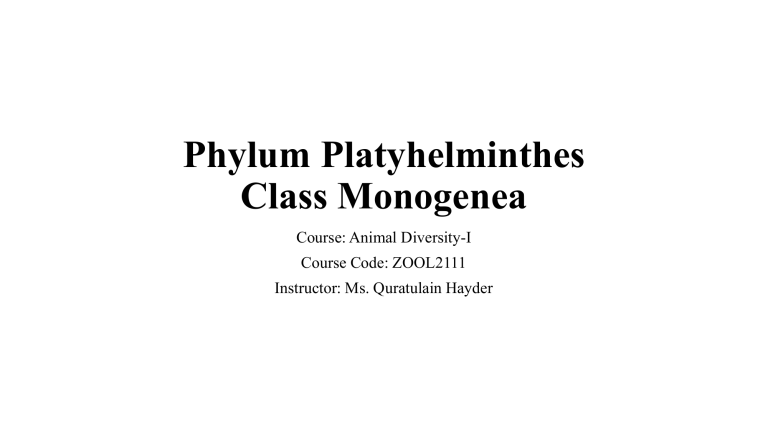
Phylum Platyhelminthes Class Monogenea Course: Animal Diversity-I Course Code: ZOOL2111 Instructor: Ms. Quratulain Hayder Class Monogenea • Monogenetic flukes are so named because they have one generation in their life cycle; that is, one adult develops from one egg. • External parasites (ectoparasites) of freshwater and marine fishes. • Attach to the gill filaments and feed on epithelial cells, mucus, or blood. Class Trematoda-General Characteristics • Adults: endoparasites in vertebrates • At least two different hosts to complete their life cycle (digenetic flukes). • Have oral sucker and acetabulum • Acetabulum- sucker located below the oral sucker on the middle portion of the body • About 1,350 species • Examples: Fasciola (Sheep liver flukes), Clonorchis sinensis (Chinese liver flukes). Life cycle of Common Liver Fluke (Fasciola Hepatica) • The eggs of digenetic trematodes are oval and usually have a lid-like hatch called an operculum. 10.12a • When an egg reaches freshwater, the operculum opens, and a ciliated larva called a miracidium swims out. 10.12b • The miracidium swims until it finds a suitable first intermediate host (a snail), penetrates in it, loses its cilia, and develops into a sporocyst. 10.12c • Sporocysts are baglike and contain embryonic cells that develop into either daughter sporocysts or rediae. 10.12d • At this point in the life cycle, asexual reproduction occurs. From a single miracidium, hundreds of daughter sporocysts, and in turn, hundreds of rediae, can form by asexual reproduction. • Redia produce hundreds of the next larval stage, called cercariae. • A cercaria has a digestive tract, suckers, and a tail. • This phenomenon of producing many cercariae is called polyembryony. • Cercariae leave the snail and swim freely until they encounter a second intermediate, which may be a vertebrate, invertebrate, or plant. The cercaria penetrates this host and encysts as a metacercaria. 10.12f • When the definitive host eats the second intermediate host, the metacercaria excysts and develops into an adult. 10.12g Chinese liver fluke (Clonorchis Sinensis) • Adult Chinese liver fluke lives in the bile ducts of the liver, where it feeds on epithelial tissue and blood. • The adults release embryonated eggs into the common bile duct. The eggs make their way to the intestine and are eliminated with feces. • In snail body, egg hatches and miracidia are released. • Following the sporocyst and redial stages, cercariae emerge into the water. • If a cercaria contacts a fish (the second intermediate host), it penetrates the epidermis of the fish, loses its tail, and encysts. The metacercaria develops into an adult in a human who eats raw or poorly cooked fish. Phylum Platyhelminthes Class Cestoidea Course: Animal Diversity-I Course Code: ZOOL2111 Instructor: Ms. Quratulain Hayder General Characteristics It is the most highly specialized class of flatworms. The members of cestoidae are commonly called tapeworms. There are following parasitic adaptations in tape worms: • 1. Mouth and digestive system is absent in tapeworms. They absorb nutrients directly from the host. • 2. Most adult tapeworms consist of proglottids. The proglottids are a long series of repeating units. Each proglottid contains a complete set of reproductive structures. • 3. The adult tapeworms live in a very stable environment. There are no environmental variations in vertebrate intestinal tract. Therefore, tapeworms do not require special structures. Their body is divided into three regions. • Scolex: It is present at one end. It contains circular or leaf like suckers. The tapeworm firmly anchors itself to the intestinal wall with the Scolex. Mouth is not present in them. • Neck: The scolex narrows to from the neck. • Strobila : It is the third body region. The strobila consists of a series of linearly arranged proglottids. • Proglottids function primarily as reproductive units. • As a tapeworm grows, new proglottids are added in the neck region. The older proglottids are gradually pushed posteriorly. • The posterior proglottids mature and start producing eggs. • The proglottids at the posterior end accumulate eggs. So, they are gravid (ripened). Nervous and excretory systems • The nervous system consists of only a pair of lateral nerve cords. • A proto-nephridial system also runs the length of the tapeworm. Reproduction • Tapeworms are monoecious. They produce large number of eggs. Each proglottid contains a complete set of male and female reproductive organs. • Numerous testes are scattered throughout the proglottids. The male system of a proglottid matures before the female system. Therefore, copulation occurs with another mature proglottids of the same tapeworm or with another tapeworm in the same host. • Female reproductive organ: There is a single pair of ovary in each proglottid. It produces eggs. • Development: The reproductive organs degenerate after storage of egg. Therefore, gravid proglottids are called as “bags of eggs”. The gravid proglottids break. • Thus, the egg is released into the host’s intestine. The proglottids are not continuously lost. Therefore, the adult tapeworms become very long. Some important Tapeworm parasite of Humans • Tapeworm species are Taeniarhynchus saginata (Beef tapeworm), Taenia solium (Pork tapeworm) and Taenia asiatica (Asian tapeworm). • Taeniarhynchus saginata, commonly known as the beef tapeworm. • It is an intestinal parasite in humans causing taeniasis and cysticercosis in cattle. • Humans are the only definitive hosts for T. saginata and T. solium. Life cycle of Beef Tapeworm. • Eggs or gravid proglottids are passed with feces. • The eggs can survive for days to months in the environment. • Cattle (Taeniarhynchus saginata) and pigs (Taenia solium) become infected by ingesting vegetation contaminated with eggs or gravid proglottids. • In the animal’s intestine, the oncospheres hatch, invade the intestinal wall, and migrate to the striated muscles, where they develop into cysticerci. • A cysticercus can survive for several years in the animal. • Humans become infected by ingesting raw or undercooked infected meat. • In the human intestine, the cysticercus develops over 2 months into an adult tapeworm. The adult tapeworms attach to the small intestine by their scolex. • Length of adult worms is usually 5 m or less for T. saginata (however it may reach up to 25 m) and 2 to 7 m for T. solium. • T. saginata adults usually have 1,000 to 2,000 proglottids, while T. solium adults have an average of 1,000 proglottids. • The eggs contained in the gravid proglottids are released after the proglottids are passed with the feces. T. saginata may produce up to 100,000 and T. solium may produce 50,000 eggs per proglottid, respectively.
